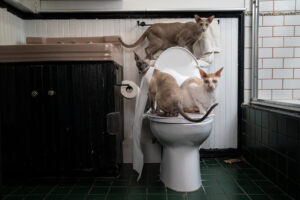
Behaviour! What a massive topic. When we are discussing behaviour, we are usually referring to unusual or unwanted behaviours. When experiencing any unusual or unwanted behaviours with your pets, it is always very important to have a thorough check up with a vet first, to rule out any underlying health issues.

DOG BEHAVIOUR
Recognising stress:
Recognising stress, fear or anxiety in animals isn’t always as easy or straightforward as you may think. Below are a couple of indicators that may help you identify stress, fear & anxiety in your dog:
- Intense focus and staring
- Licking lips
- Wide eyes / whale eyes (whites visible)
- Trying to get away, pulling away, hiding
- Tail tucked under their bottom
- Growling
- Whining
- Barking
- Lunging towards something
- Freezing
One important thing to note is, never punish your dog for displaying any of these behaviours. Your dog is using the only language that they know how to try and tell you something, and it is important to listen.
Some tips to help reduce stress, fear or anxiety with your dog are:
It is very important to give your dog a safe space to retreat to within your home. This could be a room, bed, crate, kennel, mat, etc. Their safe space should be an area where no one is allowed to enter their space. Children and other pets should be helped to understand when they are in their safe space, that they need to be left alone until they are ready to come out on their own.
Routine. Routine is a dog’s best friend. When you have a pet with any level of stress or anxiety, routine can help calm their nerves. Walks, toileting, feeding, as close to the same time as you can each day.
Food. Healthy food can make a big difference to your dogs brain chemistry so feed fresh or high quality if you can. Adding supplements like a good omega supplement and probiotic can also help with brain function.
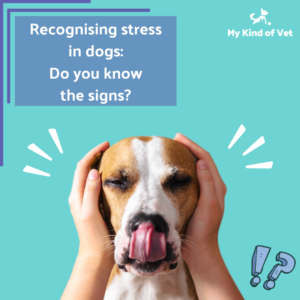
Socialising:
There is a very common misconception that socialising refers to playing with other dogs and getting along with everyone. Proper socialising refers to being calm around a variety of animals, people and situations. An over-friendly dog that runs up to every other dog it sees, is generally not a well socialised dog and is actually considered bad manners. When socialising your puppy or dog, the most important thing you are teaching them is calm, control and being at ease in different environments.
Some suggestions of things to socialise your dog with and get them used to being calm around are:
- Other dogs and other animals
- Different types of people and children, people in different outfits such as hats or helmets and big jackets
- Loud noises – play them storm sounds, car horns, emergency service alarms, etc.
- Household items like the vacuum cleaner, broom, lawnmower, etc
- Being in the car
- Being comfortable being touched and examined- especially ears, paws and mouth
- Different environments such as grass, tiles, carpet, sand, uneven surfaces, ramps, etc
- Being calm in a crate or pen (invaluable for if your pet has to go to hospital or boarding)
And remember, the aim is calm and relaxed in all of these situations.
If you would like more information on socialising, feel free to give us a call or discuss with your preferred qualified dog trainer.
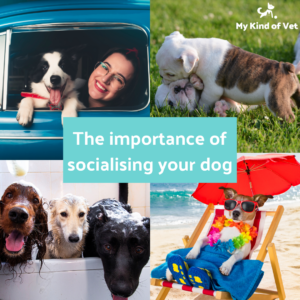
Impulse control:
What is impulse control? It is giving your dog the life skills to make good choices and help them to live calmly and happily in our busy human world. A lot of dogs and puppies may get over excited when they see a favourite human, their favourite food, their favourite doggy best friend, etc. They are acting on impulse, without thinking. This can cause a lot of issues and heartache in certain situations- running up to a dog in training and causing that dog trauma or getting themselves hurt, running onto a road, eating something they shouldn’t, jumping on a child and hurting them, jumping on or off something and hurting themselves, etc. Teaching your dog impulse control has so many benefits! Like avoiding all of the above scary situations and having a calmer happier dog that co-exists with your family in harmony.
Some impulse control exercises to start with are:
- Sitting and waiting before having dinner
- Sitting and waiting before getting pats when you arrive home
- Sitting and waiting before going in or out of doors
- Sitting and waiting before saying hello to other animals or people when out and about
- Staying on a mat or specific area when guests arrive until they are allowed to say hello
Consistency is key with any training, so make sure your family and friends are on board and you are all using the same commands and methods, in every single instance to give your dog the best chance of succeeding.
If you would like more information on impulse control, feel free to give us a call or discuss with your preferred qualified dog trainer.
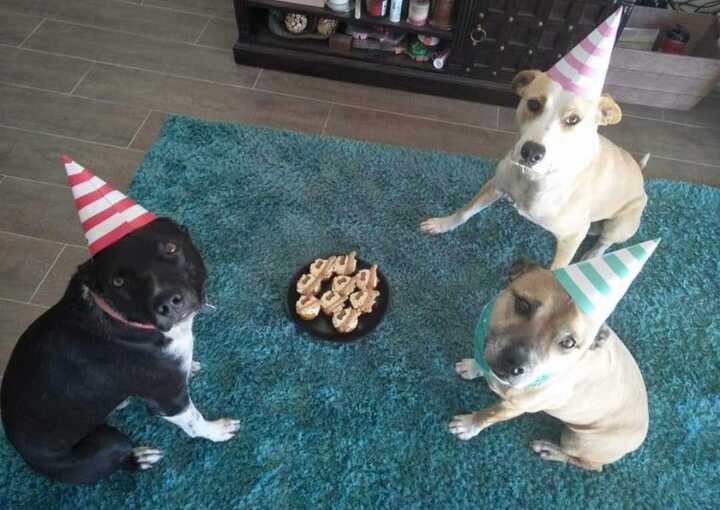
Enrichment:
What is Enrichment? Enrichment is exactly what it sounds like, enriching your dog’s life! A lot of dog negative behaviours can be born from boredom. Dogs are an intelligent species and their minds need exercising as much as their bodies. Some enrichment ideas you can do with your dog are:
- Doggy food puzzles like Kongs, licking pads, and any other kind of puzzles where they have to work out how to get the food.
- Dog classes or sports; like general obedience, tricks, agility, flyball, scent detection, dock diving, etc.
- Swimming
- Frozen treats
- Hide the treat or toy- sniff it out games
- Sniffing walks (stop every time they want to sniff and let them sniff as long as they like!)
- Training with you for fun and bonding
- Homemade puzzles and games!
If you would like more information on enrichment, feel free to give us a call or discuss with your local dog club or online community.
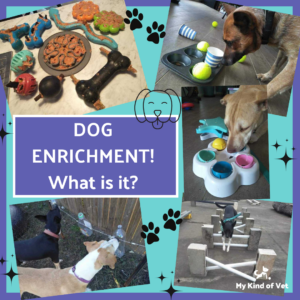
Triggers and desensitisation:
Dogs with fear and anxiety can develop “reactivity” to certain triggers. They may display fear; like trying to run away, or they may fixate, bark and lunge at certain things. We recommend consulting your vet and qualified dog trainer if your dog is showing any signs of reactivity. The sooner you get onto working through reactivity, the better it is for you and your dog, our biggest advice we can give to you is: “Don’t wait to start working on the issue”
Some important information regarding desensitisation:
Understand that your dog cannot learn while in a state of hyperarousal, intense fear/anxiety, or reactivity. Picture your biggest fear… snakes, spiders, heights? Now imagine someone throws that fear at you and then tells you that it is nothing to be afraid of, gives you a cookie, and asks you to do a maths problem. Do you think you could do any of that, or do you think you would be screaming and scrambling to get away? Your body and mind is in flight or fight mode and the stress chemicals in your brain have just gone through the roof!
Now instead picture that someone has your fear 50 metres away, they calmly make you aware of it, you are feeling safe and you have a safe exit in sight. Would you then be able to have your cookie and maybe slowly over time, edge a little closer to the fear? This is how best to approach dog reactivity.
First you need to work out what your dogs “trigger” or fear is, and then work out what their reactivity distance is. The perfect distance to begin desensitisation training is where your dog can see their trigger, but is not reacting in any way. Let them become calm in that distance, reward them, etc. Then very slowly (usually over the course of months) you may edge ever so slightly closer each training session. If there are any signs of reaction at all then you are moving too fast and need to go back a step or 2. Also keep in mind that it takes roughly 14 days for brain chemistry to return to normal after a stressful event. So if you’ve had an accidental reaction, or something else stressful has happened this can cause a setback in training and you may need to go back a few steps or give them a break in training to recover before re-starting. Desensitisation training can be a big job, so work in a team with your family, vet and qualified dog trainer.
CAT BEHAVIOUR
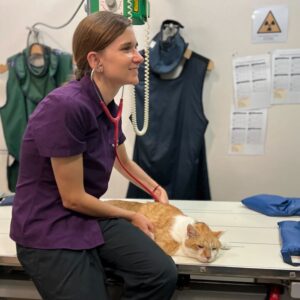
Recognising stress:
Recognising stress, fear or anxiety in animals isn’t always as easy or straightforward as you may think. Below are a couple of indicators that may help you identify stress, fear & anxiety in your cat:
- Hiding and running away
- Excessive grooming
- Unusual toileting habits
- Tail flicking
- Ears back or flat
- Hissing, Growling or Swiping
- Excessive vocalisation
- Appetite changes
Creating a calm home environment can help your cat to feel less stressed. Ensure they have a safe place they can escape to if they need to. Their safe space should be an area where no one is allowed to enter their space. Children and other pets should be helped to understand when they are in their safe space, that they need to be left alone until they are ready to come out on their own. For cats, a place up high like on a shelf or cat tower can help them to feel safe.
Things that may commonly cause cat stress:
- Changes to the home environment
- Changes to their routine
- Other pets in the home or roaming near the house
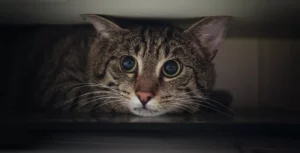
Socialising
A socialised cat is able to adapt to new people, animals, activities, and environments with more ease and confidence. They don’t make a fuss during vet visits, they’re not afraid to play with toys they haven’t seen before, and they recover quickly after getting startled by a loud noise. If there are guests in the house, a socialised cat will approach and greet them instead of going into hiding
House soiling and aggression are among the most common feline behaviour problems, and these are often a behavioural expression of fear and anxiety resulting from inadequate socialisation. By exposing a kitten to anything and everything they may come across as an adult, i.e., different people, animals, things, and places, they are less likely to end up as a fearful cat

Socialising a cat with humans:
For kittens, encourage them with lots of treats and playing. Make sure all human interactions are fun and positive, invite friends and family over so that they get used to a variety of people. For adult cats you could try getting a couple of friends or family members over; get everyone to sit in a small room, preferably with no furniture (for the cat to hide under) and nothing else that could distract the cat from paying attention to you. Let the cat wander about the room and get comfortable. Don’t touch them or reach towards them as this may create anxiety. Converse softly and move slowly and gently. Everyone hold out the cat’s favourite treat and when the cat approaches you, calmly praise them and give them a treat. This could take a while, especially if you have an older cat. By nature, cats need time to adjust to changes. You may spend 15 minutes in your first go-round with no success. That’s okay. Try again later.
After your cat begins to feel comfortable…coming to you freely and accepting treats, slowly initiate affection by scratching around the head and face. Never force yourself on a cat as it will most certainly cause them to withdraw. Remember, our goal is to make their experience positive and enjoyable
Socialising a cat with other cats:
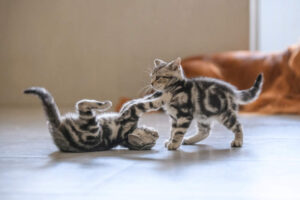
Socialising your cat to other cats will most certainly take more time and effort. Cats are highly territorial and often consider other cats a threat. Tread lightly, as you don’t want to be in the midst of a catfight. It is recommended that you introduce the “smell” and “sound” of another cat before they actually “see” each other. Safely board them in separate areas, but close enough that they can get used to the scent of the other cat in the same household. Then make introductions very slowly/ Start with a door or baby gate, and keep interactions short and supervised at first. Don’t worry if they don’t seem to like each other at first. Give them time, love and patience.
Enrichment
Just like dogs, cats need playtime and enrichment to keep them happy and satisfied. Cats love opportunities to use their natural instincts to jump, stalk, run and pounce.
Some ideas to provide enrichment for your cat are:
- Wand toys – usually a basic stick with a string attached to it with a toy or something to chase on the end
- Food puzzles- just like dogs, cats get enrichment from foraging for their food and working out a puzzle or game
- Cat towers for jumping and scratching
- Boxes and tunnels
- Providing a peaceful sunny place to nap
- Simple textured things to play with – feathers, fuzzy fabric strips, wool, rope, etc
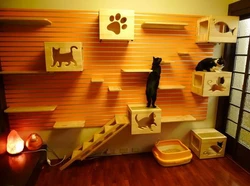
Toileting
Cats will often use toileting habits as their way to tell you that something is wrong. Step one with any cat toileting issues, is to have a vet visit for a full check up. It is important to note that if you have a male cat that is struggling to urinate, this is an URGENT EMERGENCY and can turn fatal very quickly, you need to get immediately to a vet in this situation. Stress can also cause a cat to toilet inappropriately around the home, take note of any recent changes to the home environment or routine to work out a possible cause.
If your cat is in good health, then you may try the following tips to help with urination issues:
- Choose an appropriate litter and box
- Most cats prefer unscented, finer-textured litter about one to two inches deep.
- Young kittens, elderly cats, and cats with mobility problems need boxes with low sides.
- Overweight and large cats need bigger boxes.
- Most cats prefer an uncovered box that lets odours escape and allows a 360-degree view of their surroundings.
- As a bare minimum, always have at least 1 more litterbox than you have cats. Eg. 1 cat = 2 litter boxes, 2 cats = 3 litter boxes, etc.
- Choose a good litter box location
- Most cats prefer a location that is quiet, private, separate from their feeding area, and easily accessible 24 hours a day.
- Do not locate the litter box upstairs or downstairs if your cat has trouble climbing stairs.
- Place multiple boxes in different areas of the house.
- Keep the litter box clean
- If you use clumping litter, remove feces and clumps daily and add clean litter as needed.
- A liner may help keep the box cleaner, but many cats don’t like them.
- To clean the box, scrub it with a gentle detergent, dry it, and refill with clean litter. Litter should be changed often enough so that it looks and smells dry and clean. The more cats using the box, the more often this will need to be done.
- Replace old boxes that smell or are cracked.
